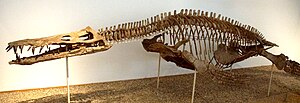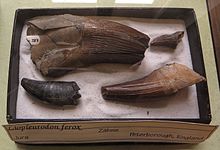Liopleurodon
| Liopleurodon | ||||||||||||
|---|---|---|---|---|---|---|---|---|---|---|---|---|

Reconstructed skeleton of Liopleurodon ferox , exhibited in the paleontological collection of the University of Tübingen |
||||||||||||
| Temporal occurrence | ||||||||||||
| Middle Jurassic ( Callovium ) | ||||||||||||
| 166.1 to 163.5 million years | ||||||||||||
| Locations | ||||||||||||
|
||||||||||||
| Systematics | ||||||||||||
|
||||||||||||
| Scientific name | ||||||||||||
| Liopleurodon | ||||||||||||
| Sauvage , 1873 | ||||||||||||
Liopleurodon is a genus of pliosaurs within the extinct Sauropterygia . This genus of marine dinosaurs iswell knownfrom fossil finds from the Central Jurassic of Europe. The generic name is derived from the Greek λεῖος ( leîos ) 'smooth'; πλευρόν ( pleurón ) 'side', 'flank' and ὀδούς, ὀδόντος ( odoús, odóntos ) 'tooth'.
features
Skull and teeth
Liopleurodon had a wedge-shaped and flattened skull. On each mandible had Liopleurodon 25 to 28 teeth. A characteristic of L. ferox is a symphysis (bone connection) in the front part of the skull, which is usually shorter than that of Pliosaurus . In this part of the skull (in front of the symphysis) there are six to seven elongated teeth with a round cross-section. The teeth in the back of the dentition have a more triangular cross-section. The teeth are sharp, serrated on one side and smooth on the other. They have a deep root, comparable to today's killer whales or saltwater crocodiles .
size
Liopleurodon reached an average length of 5 to 7 m. The specimen "Peterborough" is estimated at 6.39 m, with the skull length was 1.26 meters. This length calculation is based on the assumption of a skull: body ratio of 1: 5.19, based on the proportions of the individual GPIT1754 / 2. This has a skull length of 0.94 m and a total length of 4.88 m.
The largest skull that Liopleurodon can be assigned to is 154 centimeters long. The length of the entire animal has been estimated to be just over 10 m based on the assumption that the skull is 1/7 of the total length. However, the proportions used to make this estimate are believed to be incorrect. Instead, a ratio of 1: 4 or 1: 5 was assumed. Specimens of this size are estimated to weigh between 2.5 and 5 tons, with average specimens weighing around 500 to 750 kg. However, other models for estimating weight assume that an individual approximately 4.8 meters long could weigh just under a ton, while, according to this model, a 5.7 meter long specimen would weigh 1.7 tons.
Pliosaurus macromerus , with a lower jaw almost 3 m long, was also assigned to Liopleurodon , but this is not durable. A 4.5 m long specimen is on display in Tübingen.
Discovery story
Liopleurodon was first in 1873 by Henri-Émile Sauvage based three teeth described . One was found near Boulogne-sur-Mer in northern France and was assigned to Liopleurodon ferox ( ferox = wild). The tooth is 75 mm long. The others were found in the Cher and Calvados departments . The tooth from Cher is 70 mm long and was assigned to L. grossouvrei . Sauvage described the Calvados as L. bucklandi . Only the teeth assigned to L. ferox and L. grossouvrei were described by Sauvage. Sauvage did not investigate the relationships of Liopleurodon . Later (1909) the tooth was associated with skeletal material of an adult animal from the Callovium (Clay Formation) near Peterborough in England, and a relationship with Pliosaurus was established. Before this material was found, the validity of the taxon was controversial.
In Germany so far only teeth or tooth fragments assigned to the genus have been found, whose species is unknown (North Rhine-Westphalia, Lower Saxony).
nutrition
Liopleurodon was believed to be a top predator with strong jaws that were well adapted to vigorous biting.
Liopleurodon bite marks have been found on the bones of the plesiosaur Cryptocleidus . In general, Liopleurodon is seen as a hunter of meaty prey because of its sawed and sharp teeth. Worn teeth indicate hunting for large prey.
Pliosaurs are seen as swimmers who use a four-fin principle and hunt cephalopods, reptiles and fish in the deep sea.
In addition, pliosaurs are seen as the prehistoric equivalent of toothed whales.
Hunting behavior
The brain of Liopleurodon takes up less than 1% of its body mass one, suggesting that he was a visual predator that information very quickly process needed. This type of brain is still found almost exactly the same in the great white shark today. In addition, they were both the most successful hunters in the sea in their day. Everything indicates that their hunting behavior is the same.
The Liopleurodon likely looked out for prey-like form on the surface of the water at depths of up to 15 meters. If he spotted a prey, he accelerated extremely quickly and could jump several meters out of the water with it.
A big difference to the great white shark is the tooth shape, that of the shark is designed to slit the prey, while the thicker but stronger one of the Liopleurodon could crush the prey.
Systematics
External system
Liopleurodon is a member of the Pliosauridae family , a group within the Pliosaurs known from the Jurassic (possibly also from the Cretaceous ) of Europe and North America .
Liopleurodon belonged within the group to the basic representatives from the Central Jurassic . These differ from their relatives from the Upper Jurassic, among other things, in the number of tooth sockets and the shorter skull or body length. Occasionally, Pliosaurus species from the late Jurassic that have a similar number of tooth sockets (e.g. P. rossicus ) are assigned to Liopleurodon . This assignment is not tenable, however, since these species have the described autapomorphies of Pliosaurus , but not Liopleurodon . Instead, a convergent development of the short symphyses in Liopleurodon and some Pliosaurus species is assumed .
A 2013 study summarized Liopleurodon , Simolestes , Peloneustes , Pliosaurus, and Brachaucheininae as Thalassophonea .
Internal system
There are currently two species that can be assigned to the genus Liopleurodon :
- Liopleurodon ferox ( type species ; England and France)
- Liopleurodon pachydeirus (England)
differ from L. ferox by features in teeth and cervical vertebrae.
There are also other species for which it is still unclear whether they belong to a specific species:
- L. grossouveri
- L. rossicus , now one Pliosaurus found
- L. macromerius
- L. nova (Very little is known about this species.)
popularity
The BBC television series Dinosaurs - In the Realm of Giants featured a Liopleurodon 25 meters long and 150 tons in weight based on the assumption of an 18-meter Liopleurodon believed to be juvenile. This size is criticized, however, because this specimen was in all probability not a Liopleurodon , but an undescribed taxon: called " Monster of Aramberri ". It is also suspected that the animal was smaller than assumed (15 meters) and probably fully grown.
literature
- Henri-Emile Sauvage: Notes on the Reptiles Fossiles. In: Bulletin de la Société Géologique de France. 3ème Série, Tome 1, 1875/1873, ISSN 0037-9409 , pp. 365-385, digitized .
- Colin Richard McHenry: 'Devourer of Gods'. The palaeoecology of the Cretaceous pliosaur Kronosaurus queenslandicus. University of Newcastle, Newcastle 2009, pp. 1–460, chapters 1–6, (Newcastle, University of Newcastle, dissertation, 2009), ( online PDF; 12.49 MB ).
- Roger BJ Benson, Mark Evans, Adam S. Smith, Judyth Sassoon, Scott Moore-Faye, Hilary F. Ketchum, Richard Forrest: A Giant Pliosaurid Skull from the Late Jurassic of England. In: PLoS ONE . Vol. 5, No. 1, 2013, e65989, doi : 10.1371 / journal.pone.0065989 .
Web links
Individual evidence
- ↑ a b c Benson et al. 2013, p. 29 .
- ^ A b The Paleobiology Database Liopleurodon .
- ↑ Hilary F. Ketchum, Roger BJ Benson: A new pliosaurid (Sauropterygia, Plesiosauria) from the Oxford Clay Formation (Middle Jurassic, Callovian) of England: evidence for a gracile, longirostrine grade of Early-Middle Jurassic pliosaurids. In: Special Papers in Palaeontology. Vol. 86, 2011, ISSN 0038-6804 , pp. 109-129, online .
- ↑ a b c d Liopleurodon Sauvage, 1873. ( Memento of the original dated May 12, 2013 in the Internet Archive ) Info: The archive link was inserted automatically and has not yet been checked. Please check the original and archive link according to the instructions and then remove this notice. on: plesiosauria.com.
- ↑ a b McHenry 2009, p. 18 .
- ↑ McHenry 2009, pp. 19-21 .
- ↑ a b Judy A. Massare: Tooth Morphology and Prey Preference of Mesozoic Marine Reptiles. In: Journal of Vertebrate Paleontology. Vol. 7, No. 2, 1987, ISSN 0272-4634 , pp. 121-137, doi : 10.1080 / 02724634.1987.10011647 , JSTOR 4523132 .
- ↑ McHenry 2009, p. 23 .
- ↑ a b c d e f Richard Forrest: Liopleurodon. ( Memento of the original from January 22nd, 2009 in the Internet Archive ) Info: The archive link was inserted automatically and has not yet been checked. Please check the original and archive link according to the instructions and then remove this notice. on: plesiosaur.com November 20, 2007.
- ^ A b Leslie F. Noé, Jeff Liston, Mark Evans: The first relatively complete exoccipitalopisthotic from the braincase of the Callovian pliosaur, Liopleurodon. In: Geological Magazine. Vol. 140, No. 4, 2003, ISSN 0016-7568 , pp. 479-486, doi : 10.1017 / S0016756803007829 , online .
- ^ A b Lambert Beverly Tarlo: A review of Upper Jurassic pliosaurs. In: Bulletin of the British Museum (Natural History). Geology Series. Vol. 4, No. 5, 1960, ISSN 0007-1471 , pp. 145-189, digitized .
- ↑ McHenry 2009, p. 415 .
- ↑ a b Lambert B. Halstead: Plesiosaur locomotion. In: Journal of the Geological Society. Vol. 146, No. 1, 1989, ISSN 0016-7649 , pp. 37-40, doi : 10.1144 / gsjgs.146.1.0037 .
- ↑ Sauvage 1873, pp. 381-385 .
- ↑ Sven Sachs, Christian Nyhuis: Evidence for huge pliosaurs from the Jura of Germany. In: The stone core. Vol. 21, 2015, pp. 74-82 [1] .
- ↑ McHenry 2009, p. 34 .
- ↑ Michael A. Taylor, Arthur RI Cruickshank: Cranial Anatomy and Functional Morphology of Pliosaurus brachyspondylus (Reptilia: Plesiosauria) from the Upper Jurassic of Westbury, Wiltshire. In: The Royal Society. Philosophical Transactions. Series B: Biological Sciences. Vol. 341, No. 1298, 1993, ISSN 0080-4622 , pp. 399-418, doi : 10.1098 / rstb.1993.0124 .
- ↑ McHenry 2009, p. 33 .
- ^ Liopleurodon - The Monster from Spitzbergen - ZDF [2] .
- ↑ Benson et al. 2013, p. 30 .
- ↑ McHenry 2009, p. 451 .
- ↑ Benson et al. 2013, p. 32 .
- ^ Roger BJ Benson, Patrick S. Druckermiller: Faunal turnover of marine tetrapods during the Jurassic – Cretaceous transition. In: Biological Reviews. Vol. 89, No. 1, 2014, ISSN 1464-7931 , pp. 1–23, doi : 10.1111 / brv.12038 .
- ↑ [3] .
- ↑ Liopleurodon (LI-PLOO-ro-don). at: bbc.co.uk/science
- ↑ Marie-Celine Buchy, Eberhard Frey, Wolfgang Stinnesbeck, José Guadalupe López-Oliva: First occurrence of a gigantic pliosaurid plesiosaur in the late Jurassic (Kimmeridgian) of Mexico. In: Bulletin de la Societe Geologique de France. Vol. 174, No. 3, 2003, ISSN 0037-9409 , pp. 271-278, digital version (PDF; 3.41 MB) .
- ↑ Mine's bigger than yours! The Monster of Aramberri, Predator X, and other monster pliosaurs in the media.



